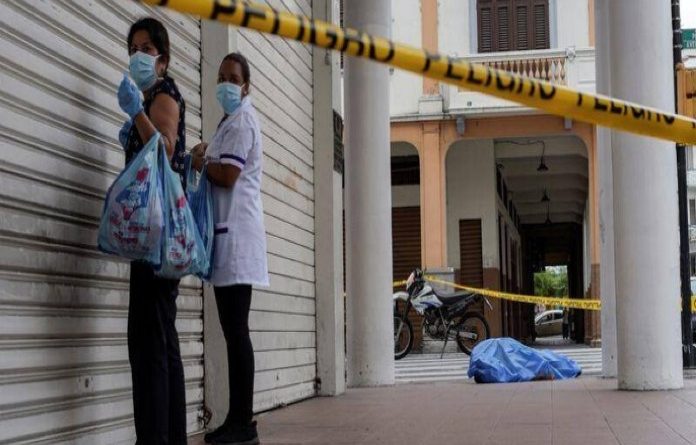COVID- 19: Ecuador Gives Glimpse Into Pandemic’s Impact On Latin America
In Guayaquil, Ecuador’s biggest city, a surge in deaths has overwhelmed health care and burial services. Scenes of bodies on sidewalks and desperate families serve as a warning for the region.
A body outside a clinic in Guayaquil, Ecuador, had reportedly been lying there for three days. Officials have been overwhelmed and unable to care for the dead quickly.
The authorities struggling to keep track of deaths. Funeral parlors, out of coffins, using cardboard boxes made by companies that usually package bananas and shrimp.
The calamity unfolding in Ecuador’s business capital, Guayaquil, offers an ominous look at how officials’ ability to respond to the coronavirus pandemic in Latin America can be dangerously hamstrung by the inequality, weak public services and fragile economies that mark much of the region.
“What we’re seeing in Guayaquil is what can happen in most of South America’s large cities, where pockets of cosmopolitan richness coexist with widespread poverty,” said Alexandra Moncada, who directs activities in Ecuador for the international aid organization CARE.
A country of 17 million, Ecuador has one of the highest official rates of coronavirus infections, and deaths, per capita in Latin America.
It is still unclear why it has been affected so deeply. Some experts believe the virus may have traveled along the country’s deep migratory links with hard-hit Spain and Italy, then spread as Ecuador lagged in adopting social distancing measures.
The streets of Guayaquil were crowded on Tuesday despite measures intended to restrict people’s movement amid the coronavirus crisis.
Ecuador’s official coronavirus death count rose to 220 on Tuesday, the latest number available, with 182 other cases listed as “probable” but unconfirmed — higher than its larger and more populous neighbors Peru and Colombia.
Ecuador’s president, Lenín Moreno, has warned that the real figure is much higher, but that because testing is limited the true extent of infections is impossible to determine.
Most deaths have occurred in Guayaquil, a dynamic port city of three million on the Pacific, which became the first major metropolis in the region to see its public services break down.
Since the start of the crisis in late March, the government has recovered 1,350 bodies from Guayaquil’s homes, according to the office of Jorge Wated, who heads the task force responsible for picking up the dead in the city. About 60 bodies are collected daily, his office said.
The virus tore through luxurious gated communities and poor, hillside neighborhoods. Within days, the explosion of mortality overwhelmed the authorities, and hundreds of bodies began to accumulate in hospitals, morgues and homes.
Lourdes Frías said she spent five days trying to get someone to collect the body of an elderly neighbor who died last week after having respiratory problems. Emergency phone lines were constantly busy, she said; on the rare occasions when she got through, she was told no one was available to help.
As the days went on, others in her building in the Socio Vivienda neighborhood of Guayaquil began to clamor for the body to be taken to the street. The police eventually removed the remains.
“Our situation is a nightmare from which we are unable to wake up,” Ms. Frías said.
The surge in deaths in Guayaquil — and the images circulating on social media of bodies wrapped in plastic and left on doorsteps — has exposed the pandemic’s potential impact on the poor in developing countries, where access to health care and other resources is faulty even in the best of times.
A woman was pictured mourning this week outside a cemetery in Guayaquil next to cardboard boxes used as coffins.
As the virus spread, some families said their loved ones had spent days seeking hospital treatment; recovering their relatives’ bodies took days, as did trying to have them buried.
The cadaver crisis reached such proportions that local cardboard manufacturers, which normally produce packaging for exported agricultural products, last week began donating cardboard coffins to the affected families.
“This is something beneficial, this is a solution,” said Pedro Huerta, whose packaging plant in Guayaquil is donating 600 cardboard coffins a day. His plant’s cardboard usually packages Ecuador’s bananas for Dole.
Like many Guayaquil residents who work in the informal economy, without benefits or job security, Ms. Frías, a house cleaner, lost her ability to earn a living when the quarantine was imposed. At the same time, shortages caused by the lockdown made food prices shoot up.
Residents say the price of potatoes, a national staple, has soared in Guayaquil in recent weeks: A dollar used to fetch five pounds of potatoes. Now it buys just one.
To alleviate the economic pain, last week the government began paying informal workers a $60 monthly stipend to stay home. The amount is about a quarter of what a housekeeper like Ms. Frías typically earns in a month.
“I always liked to have my things: my beans, my rice,” she said. “Now I’m living on God’s grace.”
The pandemic has left Ecuador’s already troubled economy with few options beyond the handouts.
The collapse of oil prices has decimated the government’s main source of revenue. An ill-timed austerity package pushed by Mr. Moreno, the president, to assuage international creditors led to the firing of up to 3,500 public health workers last year.
And Ecuador’s decision to use American dollars as its official currency, made during a financial crisis in 2000, means Mr. Moreno cannot print more money to compensate the affected workers.
The economic pressures faced by Guayaquil’s poor underline the complex class dynamics that have fueled the epidemic in the country — and that may be replicated across the continent. The virus’s ability to overwhelm capacity in Guayaquil so quickly can be seen as a warning sign for the region, said Jarbas Barbosa, assistant director of the World Health Organization’s Americas office.
“We believe everybody at some point will go through widespread community transmission” of the virus, he said.
Some of the first confirmed infections in Guayaquil were traced to well-off Ecuadorean students who had been attending school in Spain but returned to their families to escape the outbreak in Europe. Infections spread at high-society weddings last month, according to the local authorities.
By the time the virus found its way to the slums, the dynamic had reversed. While better-off Ecuadoreans were able to stock up on provisions and retreat to their homes, many manual workers have defied the government’s stay-at-home orders to make ends meet.
Residents of poor neighbuorhoods say many of their neighbuors continue to work every day, increasing the risk of contagion. Some are going door to door, begging for food.
Banks turned into high-risk areas once Ecuadoreans, many without bank accounts, showed up in large numbers to retrieve their $60 stipend in cash.
“There are colleagues who continue going out every day because they are the only breadwinners,” said Lenny Quiroz, the Guayaquil-based
Ecuador’s crisis has hit particularly hard the approximately 500,000 Venezuelans who have fled their country’s economic collapse. Unlike Ecuadoreans, they are not eligible for the government’s stimulus payments. Although Ecuador nominally has universal health care, many fear they will be the last in line for treatment.
Génesis Portillo, 26, came to Ecuador from Venezuela six months ago with her boyfriend. They both found jobs as sales assistants in the city of Machala, about three hours from Guayaquil, but lost them in the pandemic.
They said they had spent their last savings stocking up on food. The stockpile should last about a month, they said, but they have no means of getting back home if conditions deteriorate.
“I’ve found people who have helped us because they know we’re all together in this crisis, but I’m afraid of getting sick,” Ms. Portillo said. “If there’s no resources to attend the Ecuadoreans, what’s left for an immigrant?”
(New York Times)




